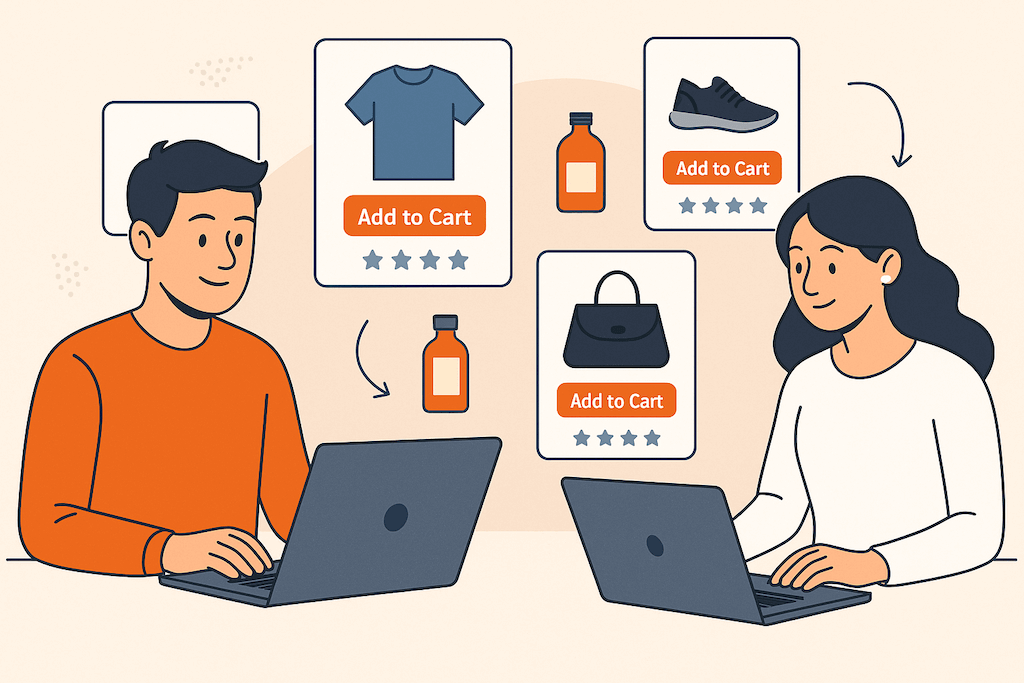The future of eCommerce is bright, as annual growth in the next four years is forecasted for global retail eCommerce sales. To leverage this growth, it’s essential to stay on top of online shopping trends and changing customer preferences and expectations. As your business gears up for 2023, read on to discover the top eCommerce trends to prepare for.
The Growth of the eCommerce Landscape
Back in 1995, the eCommerce industry as we know it was only just starting. Now nearly three decades later, it has grown into a trillion-dollar business. As a matter of fact, for 2023, global retail eCommerce sales are expected to reach $6.3 trillion. eCommerce statistics from eMarketer also point to steady growth of the industry’s share in the total retail sales — from 19.7% in 2022, it will climb up to 20.8% in 2023.
While pioneer eCommerce platforms such as Amazon and eBay were founded in the United States, China holds the title of the eCommerce market leader. Statista Digital Market Outlook predicted that the Chinese eCommerce market will generate around $1.5 trillion in revenue in 2022, while the United States comes at a close second with $875 billion.
But what sparked the astronomical growth of eCommerce worldwide? One key catalyst is the COVID-19 pandemic. As a lot of physical stores were restricted or completely shut down during its height, consumers turned to online stores to carry out their purchases. In fact, the pandemic accelerated the shift to digital shopping by five years.
Yet even without the pandemic, consumers have steadily been finding their way to online shopping through the use of mobile devices. DataReportal’s Global Overview Report reveals that 60.1% of eCommerce spend is attributed to purchases made via mobile phones, which means that mobile accessibility plays a huge role in driving eCommerce sales around the world.
The Rise of Subscription eCommerce
As more people purchase consumer goods online, the market for subscription eCommerce also grows. According to The Business Research Company, the global subscription eCommerce market is expected to reach $120.04 billion in 2022, with North America dominating the market, even as the Asia-Pacific region generates the fastest growth.
The increased demand for subscriptions is also attributed to the convenience, lower costs, and additional value provided by subscription services, all of which are appealing to online shoppers. That’s why nowadays, subscriptions are offered in different forms and in a wide range of services and products — from streaming content to curated boxes of goodies.
When it comes to the subscription eCommerce market, there are a few services and platforms that stand out. WooCommerce is one of the leading eCommerce platforms, powering 22% of the top 1 million eCommerce sites. Businesses built on WooCommerce subscriptions are able to offer flexible options to customers, and business owners enjoy a steady stream of income as they consistently meet customer needs.
The Future of eCommerce: 2023 Trends to Prepare For
Here are the nine eCommerce trends in 2023 to watch out for:
Subscription eCommerce
Acquiring new customers can be costly, and it may take a while before you see results, so the best solution for businesses is to drive customer retention. An effective way to accomplish this is through subscription services. For customers, this eliminates the hassle of manual ordering and fluctuating costs while ensuring that the product or service is there right when they need it. For businesses, the subscription model offers residual revenue.
First, identify a product or service that consumers come back for. Then develop a subscription model around it and find the right platform where you can offer your subscription service. As your customer base grows, consider upselling by adding complementary products to your subscription offering. You can also offer new product bundles or even a “build-your-own-bundle” option to personalize the customer experience.
Even with the convenience that subscription services offer, customer churn is still a possibility. To prevent this, take the time to understand your subscribers’ buying behavior. For example, if you find that they’re dropping off after their fourth weekly order, give them the option to skip the next order cycle. This way, customers can take a break without completely letting go of their subscriptions.
Omnichannel Shopping Experience
73% of buyers use multiple channels when they shop. This means they go through different platforms such as websites, social media pages, and search engines to canvas, check reviews, and compare prices before they decide to buy, whether that’s in-store or online.
To ensure that you capture consumers, create and deliver a seamless omnichannel shopping experience. If you have both physical and digital stores, eliminate the friction by implementing the following:
Keep your in-store and online inventories accurate
Enable store associates to access customers’ online accounts
Provide transparency in order fulfillment and flexible return options
Invest in immersive technologies such as augmented reality (AR) to facilitate a visual shopping experience
A Variety of Shopping Options
There are now many ways for consumers to shop, but there are three notable channels businesses should look into: mobile eCommerce, social commerce, and buy-online-pickup-in-store (BOPIS).
As mentioned earlier, mobile accessibility is a huge driver of eCommerce sales. In fact, Statista found that in 2022, smartphones accounted for approximately 73% of retail site traffic worldwide and generated 63% of online shopping orders. Retail businesses can jump in on this by offering mobile-first experiences, such as a dedicated mobile app and mobile payment options like Google Pay and Apple Pay.
Social commerce is also a popular shopping option now, particularly within the younger generation. In fact, Gen Z users prefer using TikTok and Instagram for search over Google. Consumers get product recommendations from social media, and marketplaces within these platforms are also thriving.
Lastly, BOPIS provides consumers with a hybrid shopping experience where they purchase online and pick up the items in store. It also offers flexibility and convenience, which is why the BOPIS industry is expected to reach $703 billion by 2027.
Simplified Shopping Experience
Consumers are constantly bombarded with so much information and options every day. For businesses to cut through the clutter, they should be able to provide a simplified shopping experience. Here are some ways how you can achieve this:
- Let customers get only what they need – With customizable subscription bundles, customers only pay for what they want to consume. This helps them avoid excessive orders, so they value your offers more.
- Allow shoppers to visualize and experience your products – Use augmented reality (AR) to engage your customers with 3D images of your offers, help them better understand your products through demo videos, or utilize AI and the Metaverse to deliver an immersive shopping experience.
- Offer budget-friendly options and a flexible return policy – As the whole world deals with the effects of inflation, consumers are becoming more conscious of how much they spend. Keep your customers’ business by offering budget-conscious options and develop brand loyalty by implementing a flexible and convenient return policy.
- Simplify the payment process – Encourage customers to complete their purchase by providing an easy checkout and payment process. Allow mobile payment methods such as digital wallets and offer flexible payment options.
Personalized Customer Engagement
Another way to cut through the clutter is to offer a personalized shopping experience. In fact, 60% of consumers say that this is a key factor in turning them into repeat customers. Personalization goes beyond using a customer’s first name in an email or a text message. This means leveraging first-party customer data to communicate with them in their preferred channels, offering items that match their interests or shopping behavior, and engaging with them at every step of their customer journey.
Reliable and Efficient Customer Service
The eCommerce industry is always on, so consumers expect customer service to be prompt as well. If you can, invest in 24/7 customer service assistance. Fulfill orders on time and be transparent with your order processing, shipment, and delivery updates.
Providing reliable and efficient after-sales service is just as important as acquiring customers. Make it easy for people to find help on their preferred communication channel, whether that’s through your website’s live chat, email, social media, or over the phone.
User-Generated Content (UGC)
Encourage your customers to share their experience with your business and how they use the items they get from you. UGC is a type of branded content that’s created by the users, and not by the brand itself. It’s a great way to build credibility and establish trust, because UGCs are essentially social proof in the form of customer reviews, photos, and videos. It’s a powerful tool, given that 92% of consumers trust organic UGC more than traditional advertising.
Strategic Partnerships and Collaborations
Given the meteoric rise of the eCommerce subscription market, it can be a tough business to crack into. This is why partnerships and collaborations are valuable. When you team up with the right businesses, not only can you extend your reach, but you can also gain a competitive edge by offering something unique. Partnerships can also help you increase your market share.
Sustainability
Sustainable or environment-friendly products and business practices have a reputation for being expensive. However, a study has found that consumers across all generations are now willing to spend more for sustainable products. Embrace green practices by:
Offering products made with sustainable materials and through ethical means
Investing in environment-friendly packaging or reusing packaging that are still in good condition
Giving customers sustainable shipping options (e.g. Completing all orders and sending them together rather than shipping them separately)
Allowing customers to recycle products or shop for secondhand items from your store
eCommerce trends come and go, but providing valuable offers, excellent customer service, and seamless shopping experiences will never fail to gain you a loyal customer base. Set your business up for success in the eCommerce market with sustainable practices, strategic partnerships, and a consistent revenue stream through subscription services.
WooCommerce is a reliable eCommerce subscription platform that provides you with everything you need to meet your customers’ needs. Get in touch with a WooExpert from Cultura Interactive today to get expert advice and guidance on setting up your own WooCommerce subscription.



